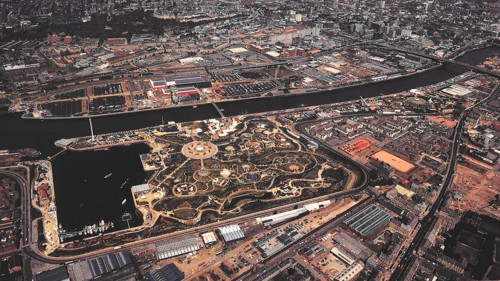Glasgow Garden Festival - Times Past

In partnership with the Glasgow Times, our archivists are exploring Glasgow's fascinating history. This week, Michael Gallagher writes about the 1988 Garden Festival.
Every day at the City Archives, we’re fortunate to work with fascinating collections that tell the story of Glasgow. Most of these are hundreds of years old but many are much more recent.
I recently worked with some records of the 1988 Glasgow Garden Festival – an event I have a hazy memory of attending as a toddler. Trust me, nothing makes you feel old more than realising something you experienced is now considered “archival”!
The Garden Festival was the biggest event in Scotland since the Empire Exhibition fifty years earlier. It ran between April and September 1988 and took place on a 120-acre site around the former Prince’s Dock, on the south bank of the River Clyde.
Glasgow followed Liverpool and Stoke-on-Trent in hosting garden festivals and continued the emphasis these British events placed on broader leisure pursuits, not just horticulture, thus providing a full family day out. For those who preferred white knuckles to green fingers, the main attraction was the Coca Cola Roller: a gravity-defying, loop-the-loop thrill ride.
Many people will remember the fabulous festival site, which was divided into six themed areas. The Science and Technology zone celebrated Scotland’s contribution to industry and included a showcase of cutting-edge gadgetry in the Crystal Pavilion. The Health and Wellbeing area featured gardens based on a variety of themes, from the United Nations to Oor Wullie, along with novel activities like yoga.
The main horticultural displays were contained in the Plants and Food area, which staged botanical exhibitions from around the world including a Bonsai garden and a German vineyard. Scottish mountains and moorlands were recreated in the Landscape and Scenery section (along with a distillery), whilst the Water and Maritime zone celebrated the nation’s rich history of maritime trade and exploration. This area was also home to the Clydesdale Bank Anniversary Tower – a festival landmark which stood 240ft high and provided a fantastic view of the festival site and beyond. Finally, the Recreation and Sport zone was the festival’s biggest event site, with an overwhelming number of concerts, performances and shows of all kinds.
The City Archives holds many records about the festival and its planning, execution and impact. These include a debate around whether the newly constructed Bells Bridge could carry the weight of a 2.8 tonne Indian elephant for a publicity event. It was agreed that the elephant, named Maureen, would be allowed to take part as long as she “does not stand on one leg” and “walks gracefully and does not run”.
Glasgow’s Garden Festival was a huge success. It attracted 4.3 million visitors - significantly more than its predecessor festivals down south. More importantly, it helped plant the seeds for the city’s cultural renaissance in the decades since and was key in the blossoming of Glasgow’s image, from the industrial city of the past to the modern, creative one of the future.
